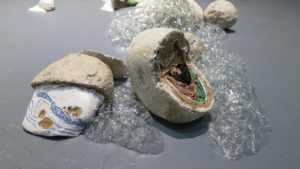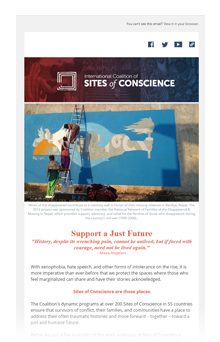The Wing Luke Museum of the Asian Pacific American Experience in Seattle, Washington is dedicated to the history and narratives of the Asian Pacific American community. Through guided tours and exhibitions, the museum immerses its visitors in stories of survival, success, conflict, compassion and hope – many of which focus on how history impacts contemporary human rights issues such as immigration. In November 2016, it debuted a year-long exhibit entitled “We Are the Ocean: An Indigenous Response to Climate Change.” In this essay, Executive Deputy Director Cassie Chin highlights some of the exhibit’s key installations and lessons to be learned.
We Are the Ocean: An Indigenous Response to Climate Change
“But what happens when islands disappear, and land is just a memory?”
Global temperatures are on the rise. Coral reefs are slowly dying. Islands are now gradually disappearing due to rising waters. Storms are increasing both in frequency and in strength. The Pacific Ocean is now filled with plastic debris. These are just some of the issues facing our oceans today.
In 2016, Asian Pacific Islander American community members in the Greater Seattle area met to explore how indigenous communities are responding to the ways climate change is affecting our waters and our lives. Their work resulted in the exhibition, “We Are the Ocean: An Indigenous Response to Climate Change,” on display at the Wing Luke Museum of the Asian Pacific American Experience (The Wing) through November 12, 2017, reaching an anticipated 30,000 visitors including 5,000 students on school tours.
Created through the Wing’s community process – which ensures input from local educators, artists and the general public – the exhibition is centered on indigenous voices and perspectives, and looks at philosophy, spirituality, conservation, culture, legacy and history as a foundation. Through art, poetry and oral history interviews, the exhibition explores both the history of climate change – specifically the ways that indigenous people were the original environmentalists – as well as the more tangible ways that global warming affects our everyday lives now, from the water we drink to the erosion of our land.
The goal can at times feel Sisyphean; climate change is so pervasive, influencing so much of our lives down to our most basic needs that coming up with the right solutions, all the solutions, can feel overwhelming. In many ways, coming to terms with that feeling and forging ahead despite it, is the “take-away” for museum staff, committee members and the general public.
“For many in our committee, they said that they don’t have all the answers to the problems facing this world, but by speaking more about the ways climate change is impacting their lives, it can bring us one step closer to figuring out how to move forward in ways that are hopeful and generative,” noted Roldy Aguero Ablao, exhibit specialist at the Wing and lead staff for the exhibition.
Below are three installations from the exhibition, each one grappling with the profound ways in which our behavior affects the environment now and for those who will follow us.

Stepping Stones, 2015 | Maika’i Tubbs | plastic shopping bags, cardboard, cigarette butts, food wrappers, plastic containers, junk mail, paper towels, posters, parking tickets, ocean plastic glue
“Stepping Stones is inspired by a new type of rock called plastiglomerate, a fusion of microplastic, wood, stone, coral, basalt, sand and seashells discovered in Hawai’i. Plastiglomerate is being formed naturally as lava flows down from the active volcano on Hawai’i Island towards the sea. Microplastics on our shores arrive via the Great Pacific Garbage Patch [a gyre of marine debris particles in the central North Pacific Ocean]. The lava melts the plastic onto the organic matter as it cools in the sea, creating a type of plastic rock. I wondered what the Earth would look like if these stones continue to form. Would all land eventually be covered in a sedimentary layer of plastiglomerate?”

Weavings, 2003-2016 | Roquin Quichocho Siongciol | a collection of woven objects, made from palm fronds from the island of Guahan [Guam], with a poem entitled, You Come From, by Selena Valence
“What is weaving? For me, it is connection – to our past and to our future. When I weave, I feel like I am weaving a history. Sometimes I like to think of each leaf as a person, coming together to create something larger than ourselves – to create community and hope. But what happens when islands disappear, and land is just a memory? As waters rise, soon there will be no leaves left to use, no trees to bring life to the island I call home. When I think of this, I mourn and I wonder what our future holds.”

Visitor Pledges, 2016-2017 | Exhibition visitors can write a pledge to themselves on how they hope to support our oceans. The pledge is based on the “One Ocean, One Island Earth,” a pledge started by the Hōkūle‘a and Hikianalia, and symbolized by Polynesian voyaging canoes, which are sailing across the Earth’s oceans to join and grow the global movement toward a more sustainable world.

